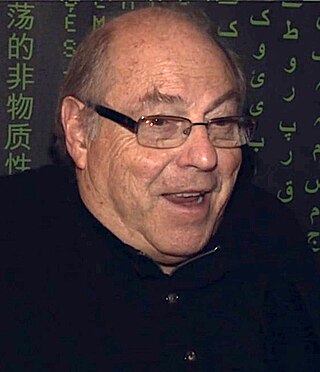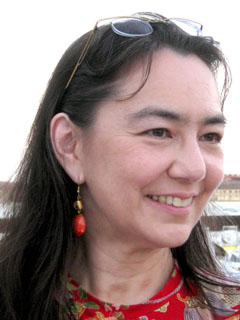Related Research Articles

Manfred Mohr is a German artist considered to be a pioneer in the field of digital art. He has lived and worked in New York since 1981.

Roy Ascott FRSA is a British artist, who works with cybernetics and telematics on an art he calls technoetics by focusing on the impact of digital and telecommunications networks on consciousness. Since the 1960s, Ascott has been a practitioner of interactive computer art, electronic art, cybernetic art and telematic art.

Georg Klein is a German sound, video and media artist and composer. Based in Berlin, he also lived in Rome, Los Angeles and Istanbul.
Blast Theory is a Portslade-based artists' group, whose work mixes interactive media, digital broadcasting and live performance.
Tom Corby and Gavin Baily (1970) are two London based artists who work collaboratively using public domain data, climate models, satellite imagery and the Internet. Recent work has focused on climate change and its relationship to technology and has involved collaborations with scientists working at the British Antarctic Survey.
José-Carlos Mariátegui is a scientist, writer, curator and scholar on culture, new media and technology. Born in 1975, he is the son of Peruvian psychiatrist Javier Mariategui and the grandson of Jose Carlos Mariategui, the most influential Latin American Marxist thinker of the 20th century. He studied Mathematics and Biology at Cayetano Heredia University in Lima, Perú and did both Masters and Doctoral degrees in Information Systems and Innovation from the London School of Economics and Political Science – LSE (London). His PhD, dated 2013, was titled Image, information and changing work practices: the case of the BBC’s Digital Media Initiative. Has been involved in teaching and research activities, as well as published a variety of articles on art, science, technology, society and development. He founded Alta Tecnología Andina (ATA), non-profit organization dedicated to the development and research of artistic and scientific theories in Latin America. Founder of the International Festival of Video and Electronic Art in Lima (1998–2003). Founding Director of the Memorial Museum of José Carlos Mariátegui of the Ministry of Culture in Peru.
Marcus Maeder is a sound artist, acoustic ecologist and composer of electronic music.

Dieter Jung is a German artist working in the field of holography, painting and installation art. He lives and works in Berlin.
Sachiko Kodama is a Japanese artist. She is best known for her artwork using ferrofluid, a dark colloidal suspension of magnetic nano-particles dispersed in solution which remains strongly magnetic in its fluid. By controlling the fluid with a magnetic field, it is formed to create complex 3-dimensional shapes as a "liquid sculpture".

Tamiko Thiel is an American artist, known for her digital art. Her work often explores "the interplay of place, space, the body and cultural identity," and uses augmented reality (AR) as her platform. Thiel is based in Munich, Germany.

Marc Lee is a Swiss new media artist working in the fields of interactive installation art, internet art, performance art and video art.

Timo Toots is an Estonian artist, mainly active in the field of interactive art and new media art. He is also the founder of project space Maajaam in Otepää.

Ars Electronica Linz GmbH is an Austrian cultural, educational and scientific institute active in the field of new media art, founded in Linz in 1979. It is based at the Ars Electronica Center (AEC), which houses the Museum of the Future, in the city of Linz. Ars Electronica's activities focus on the interlinkages between art, technology and society. It runs an annual festival, and manages a multidisciplinary media arts R&D facility known as the Futurelab. It also confers the Prix Ars Electronica awards.
Kathy Rae Huffman is an American curator, writer, producer, researcher, lecturer and expert for video and media art. Since the early 1980s, Huffman is said to have helped establish video and new media art, online and interactive art, installation and performance art in the visual arts world. She has curated, written about, and coordinated events for numerous international art institutes, consulted and juried for festivals and alternative arts organisations. Huffman not only introduced video and digital computer art to museum exhibitions, she also pioneered tirelessly to bring television channels and video artists together, in order to show video artworks on TV. From the early 1990s until 2014, Huffman was based in Europe, and embraced early net art and interactive online environments, a curatorial practice that continues. In 1997, she co-founded the Faces mailing list and online community for women working with art, gender and technology. Till today, Huffman is working in the US, in Canada and in Europe.
Thom Kubli is a Swiss-German composer and artist known for installation art and sculptures that often deploy sound as a significant element, using digital technologies and material configurations that increase the viewers' spatial perception.

Michael Bielicky is a Czech-German artist working in new media, video art, and installations. He is a professor in the department of digital media and post-digital narratives at the Karlsruhe University of Arts and Design. In 1989, Bielicky's artwork Menora/Inventur became his first work to be acquired by the ZKM Center for Art and Media Karlsruhe by its founder Heinrich Klotz.
Benjamin Heidersberger is a German media artist, journalist, entrepreneur and culture manager. He lives and works in Berlin and Wolfsburg.
The European Media Art Festival is an annual festival and congress for film and media art which takes place every April/May in Osnabrück, Germany.
Monika Fleischmann and Wolfgang Strauss are renowned German new media artists. Since the mid-1980s, they have been instrumental in bridging the gap between new media art, computer science and knowledge art. Internationally recognized for their work in interactive environments, virtual reality (VR), mixed reality (MR), and knowledge discovery (KD), they are considered pioneers in new media art, community building and integrating transdisciplinary practices.
References
- ↑ "SEBASTIAN WOLF - Sebastian Wolf". einsdreidrei.com.
- ↑ Wolf, Sebastian (11 September 2020). "Matrix" (Interview). Interviewed by Franz Zeller. Vienna: ORF (broadcaster).
- ↑ "// new media class". newmedia.udk-berlin.de.
- ↑ "Preis der Medienkunst/Mediengestaltung 2015 wurde vergeben". www.uni-weimar.de.
- ↑ "Sebastian Wolf LinkedIn Profile".
- ↑ "23rd Japan Media Arts Festival Exhibition of Award-winning Works". Miraikan – The National Museum of Emerging Science and Innovation.
- ↑ "Standorte - Goethe-Institut". www.goethe.de.
- ↑ "Negativer Raum Skulptur und Installation im 20. und 21. Jahrhundert - Karlsruhe". art-in.de.
- ↑ "Ars Electronica Festival 2016 - Brume" (PDF).
- ↑ "lovesmenot". In Kepler's Gardens.
- ↑ "Strolling Between the Disciplines". Ars Electronica Blog.
- ↑ "EMAF - Register". 2019.emaf.de.
- ↑ "Pushing the Boundaries of Human Perception through Artistic Exploration". Freunde von Freunden. 24 January 2017.
- ↑ "Sebastian Wolf & Michael Kugler". Stereolux.
- ↑ "New Technological Art Awards 2016". www.e-flux.com.
- ↑ "drawhearts". JAPAN MEDIA ARTS FESTIVAL.
- ↑ Archive, Japan Media Arts Festival. "New Face Award - drawhearts | Award | Art Division | 2020 [23rd]". Japan Media Arts Festival Archive.